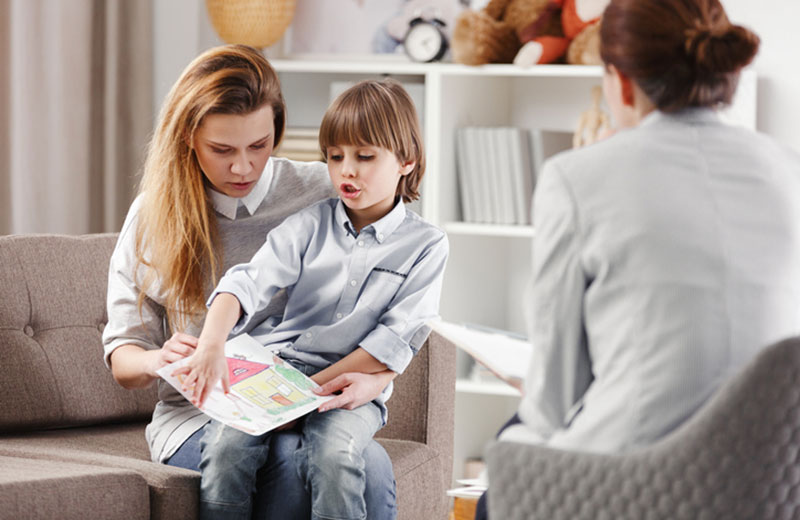Navigating Child Therapy: Tips for Parents to Support Their Child’s Mental Health
As a parent, seeing your child struggle emotionally or psychologically can be a deeply unsettling experience. It can be difficult to know how to best support them during challenging times, especially when they are facing mental health concerns such as anxiety, depression, trauma, or behavioral issues. While your love and support are crucial, there are times when professional help is needed to guide your child through difficult emotions and help them develop healthier coping mechanisms.
Child therapy is a valuable resource that can help your child understand their feelings, improve communication skills, and build resilience. However, navigating the therapy process can feel overwhelming for many parents. In this article, we will provide practical tips for parents to better understand child therapy and how to effectively support their child throughout the healing process.
Understanding the Importance of Child Therapy
Child therapy is a therapeutic intervention tailored specifically to children’s needs, focusing on their emotional and psychological well-being. Unlike therapy for adults, which may involve long discussions and complex concepts, child therapy often uses creative and engaging methods such as play therapy, art therapy, and cognitive-behavioral therapy (CBT). These approaches help children express their feelings, solve problems, and develop healthy coping strategies.
When a child is facing emotional distress, therapy can provide them with the tools to work through their problems, helping them cope with grief, anxiety, trauma, bullying, or family changes. Therapy is not only about resolving problems but also about building resilience, improving self-esteem, and teaching essential life skills.
Tips for Parents to Support Their Child’s Mental Health During Therapy
1. Normalize Therapy as a Positive Experience
Children may initially feel apprehensive or resistant to the idea of therapy, especially if they don’t understand what it involves. As a parent, it’s important to frame therapy as a positive experience, similar to going to the doctor for physical health concerns. Emphasize that therapy is a space where they can talk freely about their feelings and learn ways to feel better and solve problems. This can help reduce any stigma or fear around mental health care.
What you can do:
- Explain to your child that therapy is a safe and supportive space to express their emotions.
- Share examples of how therapy has helped others and that it’s a normal and helpful part of taking care of our well-being.
- Use simple language to help your child understand that therapy is a way of getting help for emotions, just as a doctor helps with physical illnesses.
2. Collaborate with the Therapist
While therapists typically work one-on-one with children, it’s essential for parents to collaborate and stay informed throughout the process. Therapists may invite you to participate in parent consultations, either during the therapy sessions or separately. These sessions can be instrumental in understanding your child’s progress, as well as learning strategies to reinforce the work being done in therapy.
What you can do:
- Attend parent meetings or phone consultations with the therapist to gain insights into your child’s progress.
- Be open and honest with the therapist about any concerns, changes in behavior, or family dynamics that could affect the therapy process.
- Follow through on recommendations or strategies provided by the therapist to support your child’s growth at home.
3. Create a Safe and Supportive Environment at Home
Children often feel more comfortable and open to therapy when they feel safe, loved, and understood at home. It’s essential to provide a nurturing environment where your child feels supported and heard. This means actively listening to your child’s feelings, showing empathy, and fostering an open line of communication.
What you can do:
- Encourage open conversations about emotions, even when your child isn’t directly talking about therapy.
- Praise their bravery for participating in therapy and express your support for the process.
- Be patient and allow your child to express themselves in their own time, without pressuring them to talk about therapy unless they are ready.
4. Be Patient and Give Time for Healing
Therapy is a process, and change doesn’t always happen overnight. It’s important to be patient and recognize that emotional healing takes time. Children may have good days and bad days, and therapy can sometimes bring up difficult emotions or memories that require careful processing.
What you can do:
- Set realistic expectations for progress and understand that therapy is a gradual process.
- Be supportive even when there are setbacks, and remind your child that it’s okay to have difficult moments.
- Reinforce that the goal of therapy is to help them feel better in the long term, and progress is a journey, not an immediate fix.
5. Respect Your Child’s Privacy in Therapy
While it’s natural for parents to want to know what their child is discussing in therapy, it’s important to respect your child’s privacy during the sessions. A therapist will work with your child in a way that encourages trust and confidentiality. Allowing your child to have their own space in therapy helps them feel safe and empowered to express their true feelings.
What you can do:
- Avoid pressuring your child to share details about the therapy session right after it ends.
- Discuss with the therapist beforehand what information will be shared with you and what will remain confidential.
- Reinforce to your child that they are allowed to have their own personal space in therapy and that they can share what they are comfortable with.
6. Set Realistic Expectations and Stay Involved
Therapy is an investment in your child’s emotional well-being, but it’s important to understand that results may take time. Some issues may require long-term therapy, while others may resolve more quickly. Regardless of the length of time therapy takes, staying involved in your child’s healing process is key.
What you can do:
- Be involved in your child’s progress, but avoid pushing them to “fix” everything immediately.
- Encourage positive changes at home by reinforcing the skills your child is learning in therapy.
- Celebrate small victories, such as your child learning new coping strategies or talking more openly about their emotions.
7. Model Healthy Emotional Expression
Children often learn emotional regulation by observing their caregivers. By modeling healthy emotional expression and coping strategies, you teach your child that it’s okay to feel emotions and seek help when needed.
What you can do:
- Share your own feelings in an age-appropriate way, showing your child that it’s normal to experience and express emotions.
- Use positive coping strategies yourself, such as deep breathing, mindfulness, or journaling, so your child can see effective ways of managing stress.
- Encourage your child to try these strategies at home, making it a family practice.
8. Monitor Progress and Stay Committed
It’s important to continue checking in with your child’s progress as therapy unfolds. You may see changes in behavior, emotional growth, or shifts in coping strategies. If you feel like your child is not benefiting from therapy, or if their needs change over time, don’t hesitate to discuss your concerns with the therapist.
What you can do:
- Check in with your child regularly about how they are feeling and whether therapy is helping them.
- Maintain open communication with the therapist and update them about any significant changes in your child’s life that may affect therapy.
- Stay committed to the process, even when it’s challenging, and continue to support your child in their journey toward healing.
Conclusion
Navigating the world of child therapy can be a daunting process, but as a parent, you play a vital role in supporting your child through their emotional and psychological growth. By providing a nurturing and safe environment, collaborating with the therapist, respecting your child’s privacy, and being patient, you can help ensure that your child receives the full benefits of therapy.
Therapy can be a transformative experience that equips your child with the skills to cope with life’s challenges and develop emotional resilience. By understanding the process and staying actively involved, you’ll be empowering your child to thrive emotionally and move toward a healthier, more balanced future.






